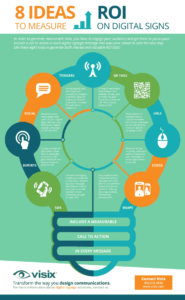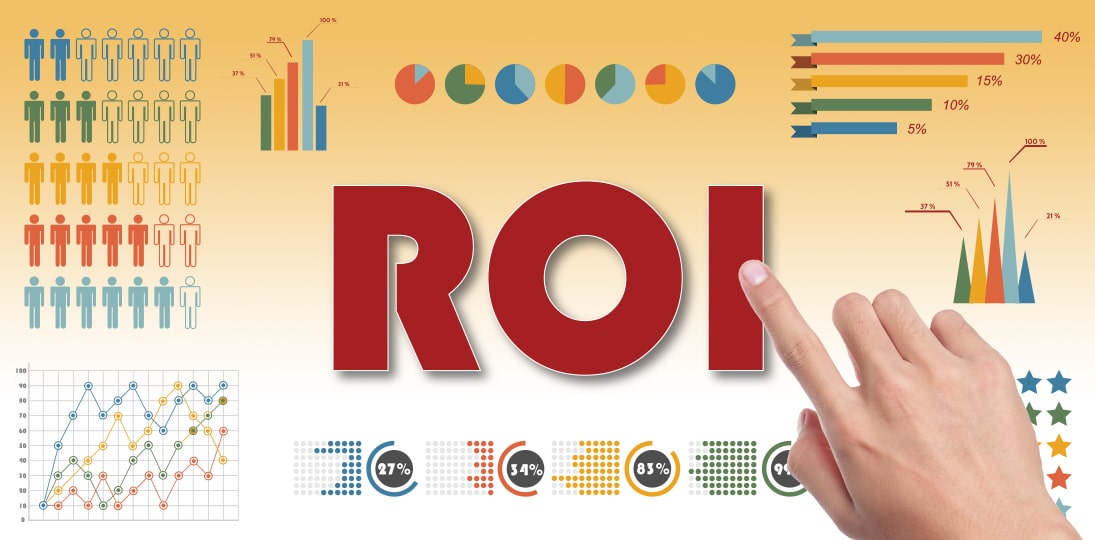Calculating ROI
Return on Investment (ROI) is a financial term, often calculated using a simple formula: sale profit from an investment minus the cost of that investment, divided by the cost (again), and the ROI is expressed as a percentage. As an example, Michaela buys $2000 of stock in Acme Corp, and later sells that stock for $2600. She takes the $2600 she sold the stock for, subtracts her initial cost of $2000, and gets a net profit of $600. She then divides that $600 by the initial cost of $2000 to get 0.3, which then gets multiplied by 100 to get a percentage of 30% for her ROI. Simple enough when it comes to money matters, but what about measuring something a little less tangible, like measuring digital signage ROI?
A digital signage system should be looked at more like marketing than straight costs vs. profits, since the goals aren’t necessarily always about money, but about engagement. John Wanamaker, founder of Macy’s, famously said “Half the money I spend on advertising is wasted; the trouble is I don’t know which half”.
Today, there are formulae for measuring marketing ROI. No matter which formula a company uses, the goal is to get the highest return possible and to increase that ROI percentage over time. One method looks at gross profits vs. marketing budget, another uses Customer Lifetime Value (CLV) in place of gross profits. This seems a little closer to what we might think about when considering digital signage ROI, but still deals with income from sales.
Digital Signage is Different
Marketing is used to try to influence people to choose your products and services over those of your competitors. Much of retail digital signage is used in this way. But organizational digital signage is different – it’s used to inform and entertain internal audiences and visitors, so they engage with the organization, understand its values, and stay updated and motivated to internalize a message or take a desired action.
There are measurable costs to set up and maintain a digital signage system:
- Hardware (screens, media players, etc.)
- Software (content management software, design applications, OS updates)
- Infrastructure (network, power, cabling)
- System training
- Content subscriptions
- External design services
- Support and maintenance contracts
- Labor for consulting, installation, etc.
Then there are the additional operational costs of paying staff to create and schedule content, and generally maintain the digital signage system.
That’s all easy enough to add up. But it’s very difficult to assign dollar values to the results of general communications that aren’t sales-focused. Many of the benefits are intangible (brand loyalty, guest experience, employee morale, etc.), and contribute to other larger business factors (employee retention, guest satisfaction, etc.). So then, what is the “profit” from digital signage?
Instead of Return on Investment (an accounting benchmark), focus on specific goals for individual communications or campaigns by looking at qualitative feedback, behavioral changes and business outcomes. Borrow ideas that come from measuring internal communications, where professionals use SMART objectives, KPIs and other tools. Instead of Return on Investment, a better term for this might be Return on Involvement.
What has value here isn’t money, but information. So, to measure digital signage ROI, you need to have information that tells you:
- If people are “engaged”
- If they’re having a “good” experience
- If they’re “informed” or “entertained”
- If they’ll continue to use the digital signage system because they “feel” it’s valuable
Objectives Determine the Task
It is essential that you have a clear idea of what exactly you want your digital signage system to achieve. Is it to improve productivity? Increase event participation? Improve the guest experience? Boost online interactions? Your goal has to be relevant and measurable, and shouldn’t be simply “to give people information”. Your objectives will determine both what you’re going to show on digital signs and how you’re going to judge success, so they need to be well-thought-out.
The weird truth is that we care about what we measure, not the other way around. So, make sure you figure out what you want to know before you decide on methodology. It’s easy to publish statistics and graphs, but they are ineffectual without analysis that you can use to further your goals. Measure something that is useful and gives clear data, or you may find yourself going down a rabbit hole following unproductive lines of inquiry.
Since a lot of the answers to engagement questions are subjective, a good way to get those answers is quite simply to ask your audience. But there’s another powerful tool as your disposal – one that you should already be including in every message, and one that turns each message into its own digital signage ROI measurement tool – a clear call to action.
Using Call to Action (CTA)
A call to action is a statement designed to get an immediate response from the person reading it. Every digital signage message should have a call to action included that asks the viewer to do something, so you know if audiences are seeing, understanding and engaging with your visual communications. This can be something simple like a URL to visit for more information, a QR code to download something, or a coupon code to be redeemed on site. The CTA just needs to be unique and measurable, so you can track where participants come from.
With a well-crafted CTA, you can measure digital signage ROI immediately for any particular message or campaign to see how it performs. If people take the action the message prompts them to take, then it worked. And the number of people who take that action give you a measurable data set to work with.
As an example, Acme Corp. decides to measure how their digital signs are performing. They choose a work week (five days) as their measurement period, then figure out how many people are exposed to the digital signs in that period. Let’s say the estimated audience is 1,000 people that week (employees plus visitors).
During that week, they showed a total of 30 different messages in playlists, dayparted for various high traffic and low traffic times throughout the week. Each message had its own CTA, and those actions were taken a total of 100 times. So, 1000 people took 100 actions on messages in a week. That means that 10% of people actively engaged with the digital signs.
But each message can also be looked at individually – one message may have had 12 actions taken, while another might have had zero. What is it about the message that had 12 actions taken that made it so successful? The subject matter? The layout or images? The wording? The reward for taking the CTA (entry in a raffle, a discount at the cafeteria, etc.)? How easy is was to actually take the action? Some basic A/B testing with different message designs and CTAs can help clarify the data.
You could even parse the information further. For example, each message displayed for 15 seconds every time it came up in the playlist, and repeated every 12 minutes over an eight-hour period on days it was scheduled. This means that a specific message was shown 40 times in a day (for 15 seconds each time – a total of 600 seconds or 10 minutes). The message was shown on three days in the five-day week, so it was displayed 120 times (for a total of 30 minutes). In that time, let’s say 10 people followed the CTA. So, the CTA was followed every 12 times is was displayed, and dividing the number of actions taken (10) by the total number of times it was displayed (120) gives you an ROI on that message of 8.33% overall.
When people are following a message’s CTA, you can be pretty certain they are engaged. You might experiment with increasing the number of times a message is displayed in a week to see if that improves the ROI numbers. You can also continue A/B testing with different designs – but make sure you don’t overlap the two campaigns and that they are shown in the exact same circumstances (same days, times and viewers) so you are comparing apples to apples.
There are probably dozens of ways to slice up the information you get simply from people following your calls to action. What you don’t want is to overanalyze things and get bogged down in lots and lots of numbers. But by using CTAs to help you measure your digital signage ROI, you can craft and assess against a very simple goal – to increase the number of actions taken on each message.
By looking at what makes some messages “successful” (ones that have higher than average actions taken), see what they have in common, and try to introduce those same elements into less successful messages. Then measure again to see if the less successful message see increases in actions.
This is a continuous process of assessment and adjustment, trying to isolate the elements of messages that get people to follow the CTAs, and increase actions taken for all messages. This cycle never stops – it’s part of managing and improving your digital signage system’s effectiveness.
Assess by Asking
Periodically, you will want to know exactly what impact your digital signage system is having on your audience. So ask them. There’s only so much you can surmise from external observations.
You should already be assessing the overall system once or twice a year with walkthrough audits and by observing how people react to the digital signs. Do viewers stop and look at the screens? If you have a touchscreen, do people interact with it? For how long? Do they smile or seem interested or entertained when they look at your messages?
This can be supplemented by surveys promoted on the digital signs themselves with a short URL to an online survey, or physical forms located near the screens. Make participation anonymous so people feel they can be honest, and make them fairly short, so people feel like participating won’t take up too much of their time.
Surveys can give you limited quantitative data (how many messages do you remember from last week?), but will mainly give you qualitative feedback that is vital to a successful digital signage strategy. By knowing what your audience responds to, or does not like, you can tailor your messages and campaigns to their tastes, all with the goal of increasing engagement.
Why ROI Matters
If you don’t assess your digital signage in a coherent, methodical way that’s tied to your overall business goals and communication objectives, you’ll then find yourself in a bad position. You’ve spent a lot of time and money getting the system up, and continue to dedicate resources to design, content management, system updates, training and the like, and all for unknown reasons.
Try and imagine your CEO coming to you and asking about ROI for your digital signage. How bad would you feel if you have to answer “Well, I don’t really know if it’s worthwhile or not.” Imagine you have to justify your budget to someone who holds the purse strings (because you’ll likely be asked to do just that at some point). What would convince them that they should continue funding the project? Whatever you answer that question with is what you should be measuring in order to determine your digital signage ROI.
For more great ROI tips, download our white paper >>
Here’s an infographic with 8 Ideas to Measure Digital Signage Success that you can start using today. (Click for the large version.)

